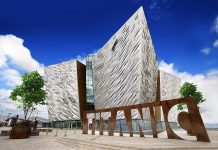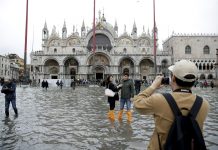This post may contain affiliate links. We may earn money or products from the highlighted keywords or companies or banners mentioned in this post.

Can an enigmatic Argentine, a pantheon of starchitects, a Hollywood director, and $1 billion cement Miami as the culturati’s ultimate playground? Alan Faena says yes.
On a perfect December day during the high-toned hubbub of Art Basel Miami Beach, the Argentine developer Alan Faena was hosting a barbecue in the middle of a construction site for several dozen collectors, influencers, and international aesthetes in town for the fair. Sides of beef and pork were roasting on a giant wire rack over an open fire, and a band played nearby. The buffet line stood in the shadow of the 18-story condominium he’s building. Designed by Foster & Partners, its 47 apartments hover on thick, polished-concrete piers. Two gutted 1940s-era hotels that Faena owns, the Saxony and the Versailles, bookend the site, which stretches from 32nd Street to 36th Street on both sides of Collins Avenue. The façade of the empty Versailles was tattooed with the oversize graffiti tag of French nightclub impresario André Saraiva—a cartoon man with a big smile, one eye, and very long legs, like a junkie version of a McDonald’s Fry Guy.
When Faena District Miami Beach is completed, in 2017, it will be home to three condominium buildings, two hotels—one renovated by filmmaker Baz Luhrmann and his production-designer wife, Catherine Martin—as well as shops, a garage, and the Faena Forum, a theater and arts center designed by Rem Koolhaas’s firm, OMA.
But that was still a ways off. On this day, guests arrived along a gravel road lined with trailers, had their Rolls-Royces and Mercedes-Benzes valet-parked, and stepped out to face a peculiar golden clock, designed by Studio Job, that had two disembodied hands sticking out of its sides and was surmounted by a whale spouting white liquid with a crown resting on top. The guests didn’t take the time to decode its meaning before chowing down on barbecue served on Faena-branded plates at long tables set up on a deck built between the boardwalk and the temporary sales office, which Faena calls the “Collaboratory.” Inside, on a big flat-screen TV, a video about the project played on a loop. The screen blinked red: “Creating Utopias,” it read. “A story about Dreamers…about Rebels…about the Agents of Change….” A picture of white-clad Faena, strolling in a garden, faded in and out.
Amid all this, Faena drifted among groups of attendees, smiling courteously, guided by his public-relations people. He looked a bit pensive with all the activity around him; he’s not instinctually gregarious, more in his head. Yet it’s always easy to spot Alan Faena in a crowd: just look for the white fedora. He always dresses entirely in white, and sometimes carries a cane. He seems to be costumed for a role he plays—romantic, mysterious, idealistic, and, as the hat indicates, always with the most high-flown of intentions. We exchanged a few words and set up a time to talk after the Art Basel hordes had left.
Faena has come up from “the south,” as he puts it, to make his mark on the United States and to leave us better for it. Having transformed a disused docklands area in Buenos Aires into a widely admired New Urbanist showplace with a hotel, residences, and a well-regarded art center, he intends to make just as big a splash in North America. And he’s starting in one of the most competitive hospitality markets in the world, where every few months, it seems, another hotel raises the bar for luxury on the sand. This one will be its own $1 billion village, like an epic live-in movie set with 219 hotel rooms and 118 condos spread across six city blocks. It’s already attracted the sort of people who can afford the unaffordable. Foster’s futuristic space fortress by the beach will reportedly be home to Goldman Sachs Group CEO Lloyd Blankfein, Apollo Global Management cofounder Leon Black (who is a MoMA trustee), and art dealer Larry Gagosian. Its $60 million penthouse is the most expensive private dwelling ever sold in Miami Beach.
Faena and his backer, the Ukrainian-American financier Len Blavatnik, have spent $550 million accumulating the property, starting with the once-glamorous Saxony, built in 1948. (It had been slated to become a Cipriani hotel, but that deal fell apart.) Faena told the Financial Times, “This is about regeneration. We found these bits of land that were unloved.” But it’s also about competing in a kind of arms race in Miami to meet the perceived needs of a rarefied new class of global resort consumer, one who wants his luxury experience elevated by art and starchitecture. Oceana, a slick condo 60 or so blocks north on Collins, advertises the presence of “superlative sculptures from renowned artist Jeff Koons.” The developers of a condo called Muse hired Helidon Xhixha to create a custom sculpture for each buyer. And Julian Schnabel was conscripted to design the sales center for the 64-story Brickell Flatiron condo.
But to Faena, this is not just another stack of luxury apartments. He sees it as a community, a place set apart, or aloft, from the everyday. The Forum is the conceptual heart of the complex, even if it was, that sunny afternoon, just an empty lot across the street. After the Forum opens late this year, the plan is to host a ballet, inspired by the Jonathan Safran Foer book Tree of Codes, and 109created by the British choreographer Wayne McGregor, in collaboration with the artist Olafur Eliasson and Jamie xx of the band the xx.
As Faena wrote in a hardcover book produced to promote the project: “The interconnection between humanity and nature embodies our holistic southern vision.” He intends for the development to “bring a new point of view of doing things or feeling things…. This installation is a perfect balance between art, architecture, nature, and technology, and has been conceived to enhance people’s lives.” To those who can afford it, and have a taste for it, it certainly will, even if the rhetoric can get a bit thick.
Arguably, what makes the Faena development possible is Art Basel Miami Beach, which in 2002 began to transform this flashy but somewhat empty-headed resort town into a gathering place for the art-obsessed super-rich. Philip Levine, the mayor of Miami Beach, underscored the point for me over coffee at his 1930s house on a gated island: “What Art Basel’s created, and what it brought to us, and the tentacles of Basel, has only reinforced the importance of the arts in our community. Having these people come to Miami Beach with a lot of their huge collections….”
The new people, said Silvia Karman Cubiñá, the director of Miami Beach’s Bass Museum of Art, are “very global. They’re not only Latin American anymore. There’s also a Russian component and a New York component— all sorts of different people.” And in a resort town with only 90,000 permanent residents, “there’s no establishment here.” People can move in and make of it what they want.
What has followed has been a kind of next-level gentrification (oligofication?). According to Knight Frank, a London real estate consulting firm, Miami is the seventh favorite city of the ultrarich, ahead of Paris and Dubai (London and New York are always first or second). This has given rise to high-end pieds-à-plage that often function as safe-deposit boxes for skittish overclass people from other parts of the world. As Levine put it, “If Brazil is booming and Venezuela collapses, Miami benefits. If Venezuela suddenly explodes, and Brazil goes south, we’d benefit as wealthy Brazilians choose to come to Miami.” And to keep them here, you have to give them something to do—high-minded hangouts like the year-old Perez Art Museum by Herzog & de Meuron and the Frank Gehry–designed New World Symphony concert hall, along with plenty of luxury-goods shopping.
“I don’t think of myself as a real estate developer,” Faena told me when we met up in Miami a week after Art Basel. “I am not. I think of myself as a theater director.” For a 51-year-old man, there’s something appealingly childlike about him, a kind of lofty impatience. Journalists often compare him to Jay Gatsby, another white-clad man of mystery.
I was staying in the one part of the project that is already open, Casa Claridge’s, a Spanish-style inn with an atrium that feels like a living room in the Hollywood Hills. Faena bought it when it was, he says, “very much a destroyed place,” and it’s been charmingly and unpretentiously renovated. In Faena’s mind, Claridge’s, where rooms run around $400 per night, is where the artists stay. You need to have artists around because, he said, “it’s what makes the district alive.”
Faena has always been a dreamer. “My ideas are always so big, and you feel alone in the thinking, in the creative process,” he said. In 1986, when he was 22, the son of a second-generation Syrian Jewish textile manufacturer, he launched a boldly colored sportswear line, Via Vai, in Buenos Aires. He sold the company in 1995 and moved to his beach house in Punta del Este, Uruguay, where he spent his time gardening. He was also active on the polo social circuit, where he became friendly with some influential New Yorkers, including the financier and art collector Adam Lindemann and his friend the investor Chris Burch. A bit more than a decade ago, he got the idea to build a hotel in a century-old grain depository in Puerto Madero, an abandoned industrial area in Buenos Aires. He hired Philippe Starck to do 134 APRIL 2015 TRAVEL+LEISURE the hotel and Foster & Partners to design the residences. He convinced Ximena Caminos, a curator at the city’s Latin American Art Museum, that “he wanted to do art as part of the hotel,” she recalled. “I didn’t understand it, but he made me curious.” So she agreed to help him open the hotel, which she thought of as a “Kunsthalle with beds.” It was, Faena told me, “an impossible plus an impossible plus an impossible.”
Argentines, Caminos explained, “are very conservative. We had to change the mind-set of the city.” The plan was to “expand people’s lives,” Faena said. To Caminos, the question was, “How do we use art as a bridge? It might be naïve, but how do you use it to cure social problems? It’s such a disaster, this world that we live in.” Three years ago, they opened the Faena Arts Center, which runs as a nonprofit, around the time she and Faena had a son. “We own a hotel but that’s not in our hearts,” she said.
The success of Puerto Madero impressed Mayor Levine. “Faena created a city within a city, a place where people went for culture, style, security,” he said. “It became a game-changing project, not just for Buenos Aires, not just for Argentina, but it was game- changing, I think, for Latin America, to be able to see how an artistic development can really make a major difference.” In Miami, he told me, he intends to “give Alan the most freedom at what he’s trying to do, because we know we’ll get the most from him that way.”
The project has had a long road: according to one person who worked with Faena, they’d originally wanted to have their follow-up venture in New York City, but changed tack when the Miami property became available. Well-connected New Yorkers, including the publicist Nadine Johnson and the writer and Warhol scene-maker Glenn O’Brien, consulted for a while before moving on. And before Luhrmann and Martin came aboard, Roman & Williams, designers of the Ace and the Viceroy in New York, among many other hotels, worked on the project.
The firm’s co-owner, Robin Standefer, told me, “Alan is the kind of person who is always collecting, searching…. He has this intoxicating vision.” She said the design team would go to Argentina to meet with Faena. “There were too many words. Months and months and months of words from the man in the white hat. Words and words and birds flying out of the mouth and creating a new universe and reinventing the world.” They disagreed too often with Faena and eventually resigned. “At the end, the self-importance I couldn’t get behind…. That is a hotel selling $50 million residences,” she said. “There is no shame in that, but you cannot pretend you are saving lives.”
Luhrmann and Martin became involved about 18 months ago, through a friend in the music business who worked with Blavatnik (he owns Warner Music). They’d never done anything like this, but were intrigued. Martin told me they want the hotel “not to feel like a gut-renovation” (which it is) “but a thoughtfully kept historic building, not musty and run-down.” Their inspirations were the Chateau Marmont, in Los Angeles, for its “bohemian charm,” and the Hôtel du Cap, outside Cannes, for “the extraordinary old-worldliness, the perfection, without being pretentious or self-conscious.” And yes, confirms the production designer of The Great Gatsby, there is something “slightly Gatsbyesque” about what she and Luhrmann came up with.
Faena took me on a tour of the building site, which is hidden behind a bright red fence whimsically decorated by Studio Job with cartoonish art references, from Michelangelo to Jeff Koons. He wore white- frame aviators, white Crocs, white pants, and a white sweater, despite the fact that we were going to be plodding through dirt and wet concrete.
One of the appealing things about Faena (besides his unfailing courteousness) is how he exists in his own imagination. Walking through the half-built spaces, he appeared to be living in a virtual-reality future where, instead of hard-hatted workers carrying buckets of balcony sealant, we were surrounded by fashionably dressed guests heading to dance the tango at the nightclub they’re building along one side of the Saxony. He’s been doing this from the start: walking the building, trying to visualize what will be there. “Every walk I take I realize new things,” he said. “I can imagine how other people walk. What they will do.” A good hotel, he said, “is like a movie.”
We walked upstairs into the Foster-designed tower, which is ringed by broad, curving, stacked verandas. The condo he’s creating out of the Versailles will have them, too. He wants to “bring this bit of how we live in Uruguay,” he said. “That invites the people to be outside.” You see, he’s trying to “offer a way of living,” and the balconies “will have the people really not only enjoying the architecture but enjoying the simplicity of how you offer a way of living to others.” For him, it’s more than a business deal. “We only sell 40 percent of everything we build,” he said. “The rest, we love to create a culture and a way of thinking, to elevate and change cities….”
He took me to the doorway of one of those balconies, cautioning me to not step out onto the still-wet waterproofing goop. I could see the curved parapet plowing straight out toward the ocean. “It’s like being on a boat,” he said with pride. On our way down, he noted that the building’s massive pillars will meet the ground in a shallow pool of water, an elegant Modernist gesture, “like a museum.”
Around back, we ran into the art collector and investor George Lindemann, jogging on the boardwalk with a good- looking young man. Lindemann is the president of the board of the Bass Museum, and he and Faena shook hands. Lindemann told me: “He’s a superstar.” There’s no question he’s won over the locals. “When you hear that name Faena,” Mayor Levine had said, “it’s a little bit like Oz. It’s a little bit like Dorothy wanting to go to the Emerald City and finally meet the wizard. I think Alan is a modern-day wizard of Oz, but in a very positive way.”
What’s behind the curtain? Deft marketing, certainly, at the height of another Miami real estate boom—by February, prices at new beachfront condos would average $1,267 per square foot, up from $907 in mid 2013. But there’s more than that: a deeply felt belief that art can continue to transform Miami for more than just those who are rich enough to buy it. As Faena told me, “I think that this city has the potential to become the place in America to be.”










